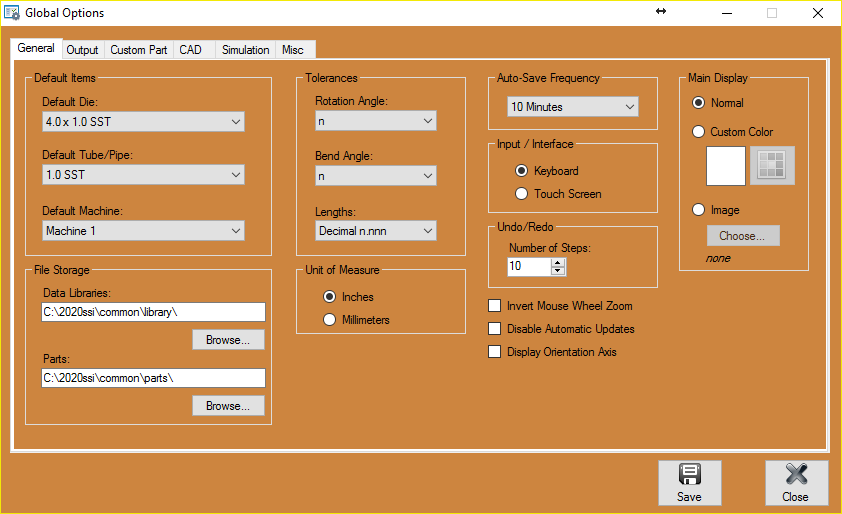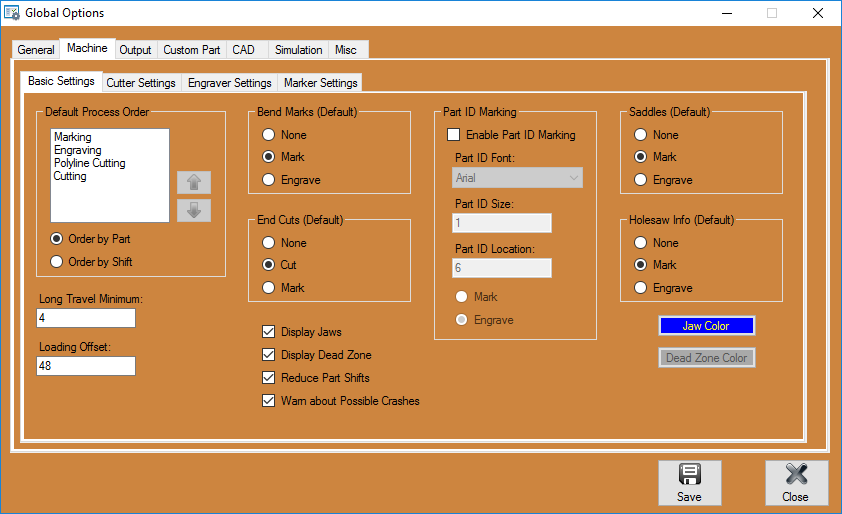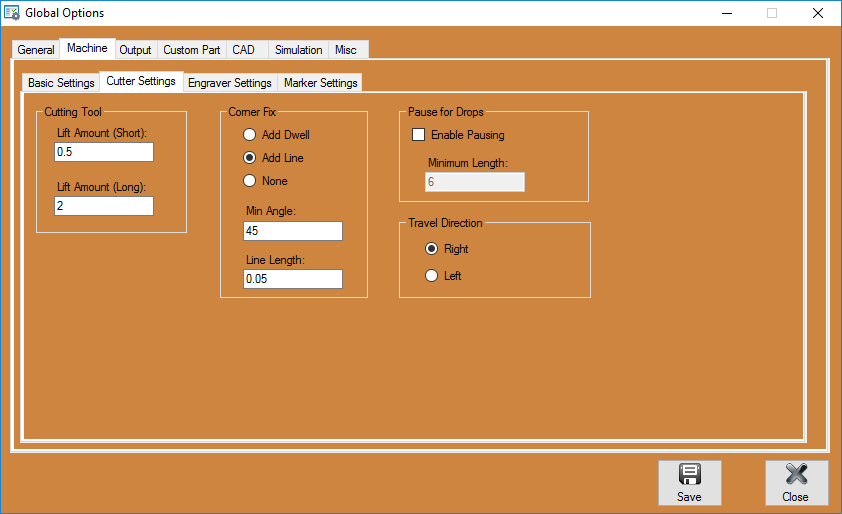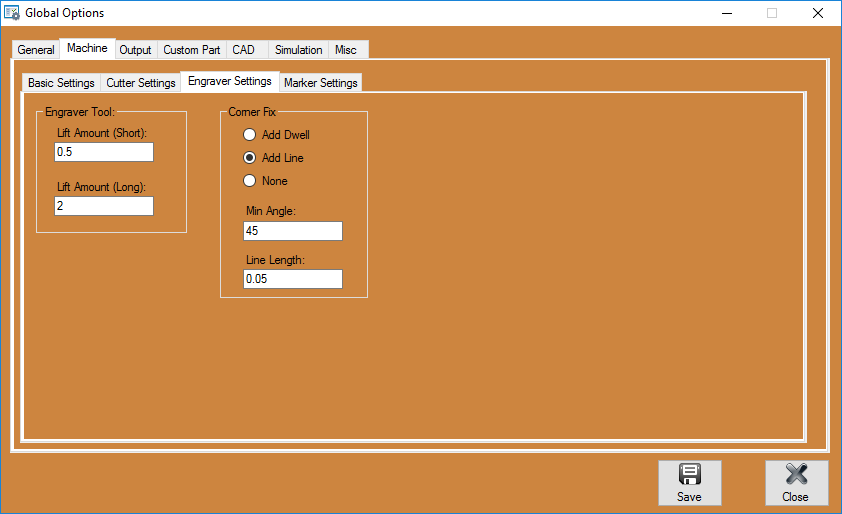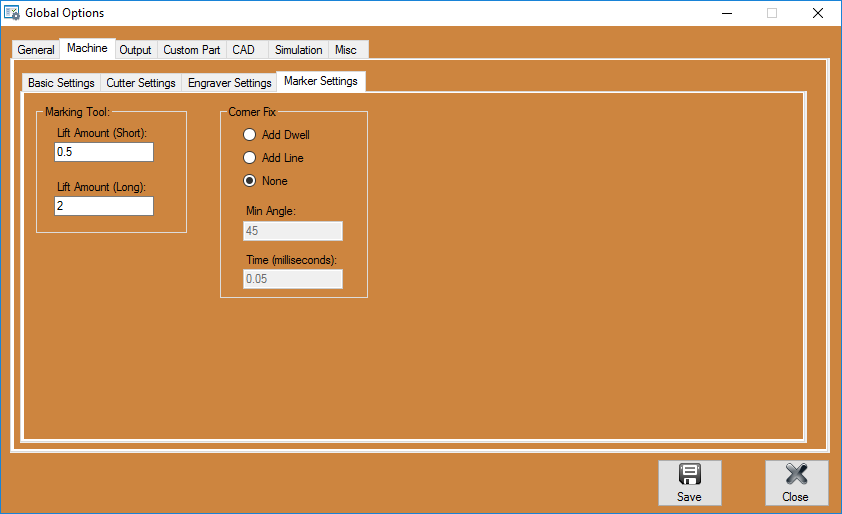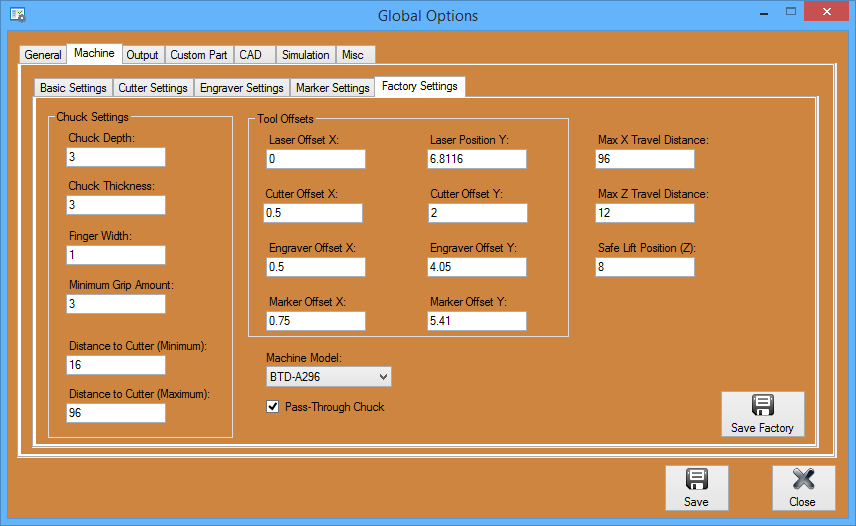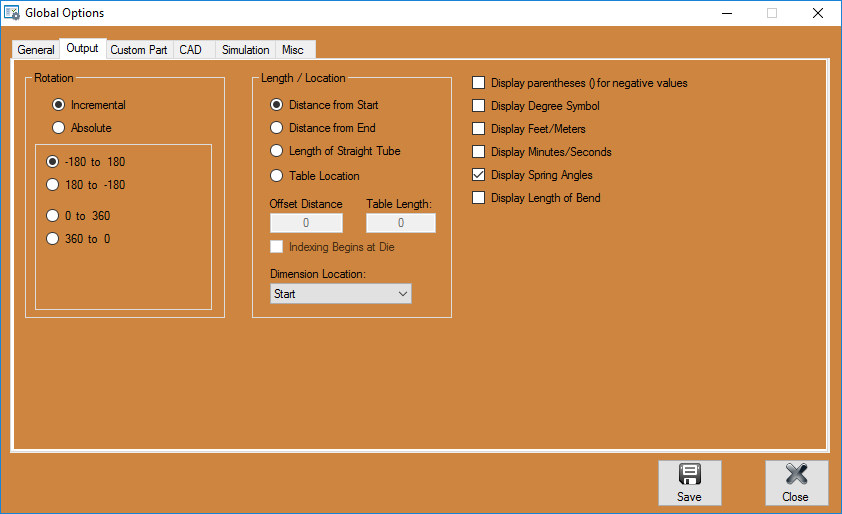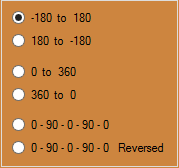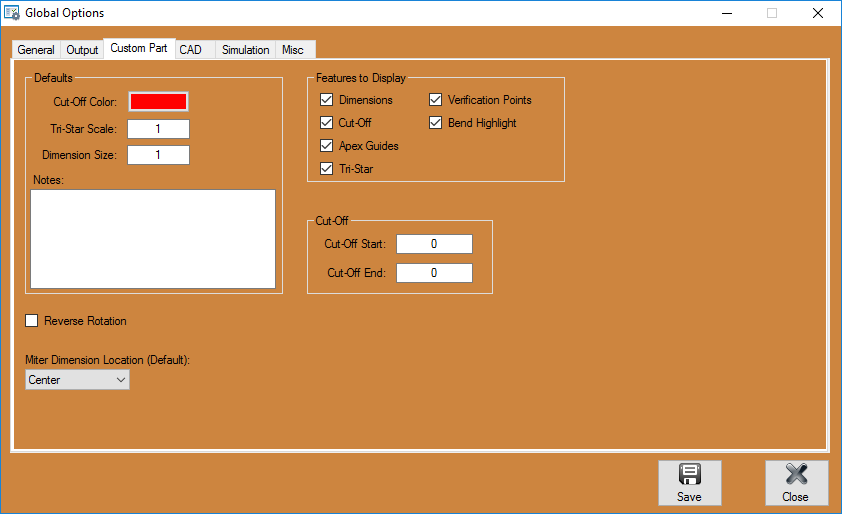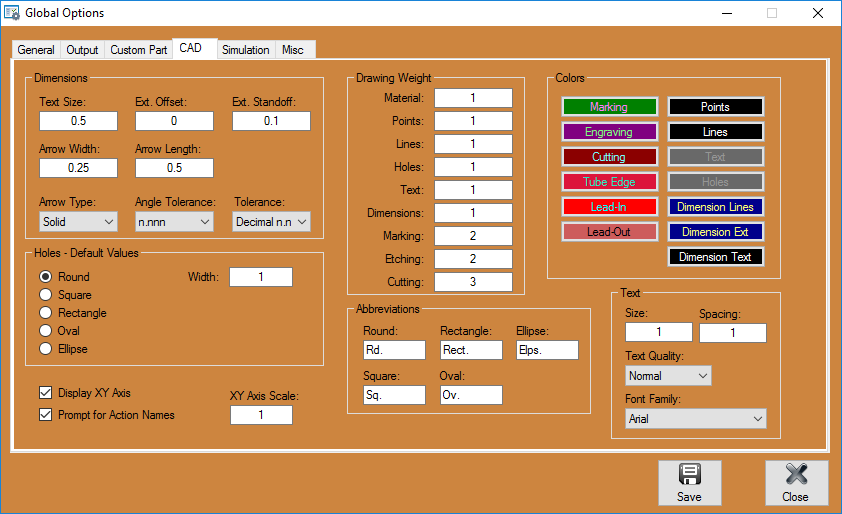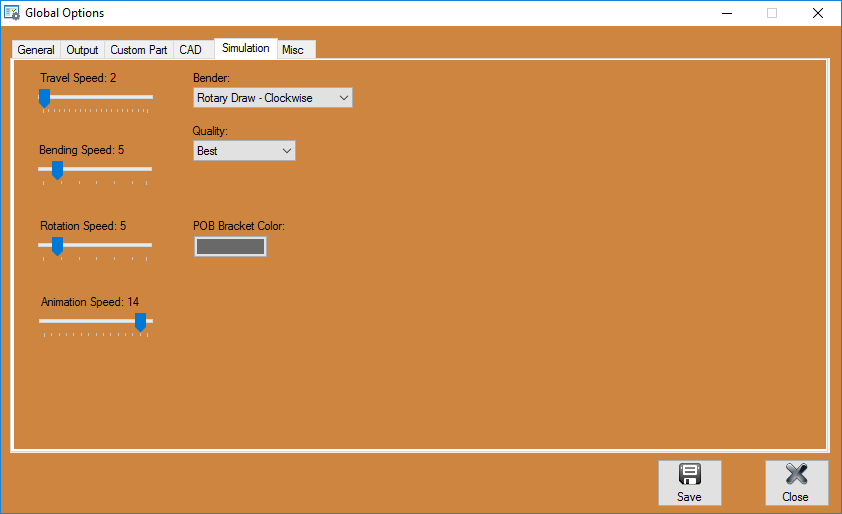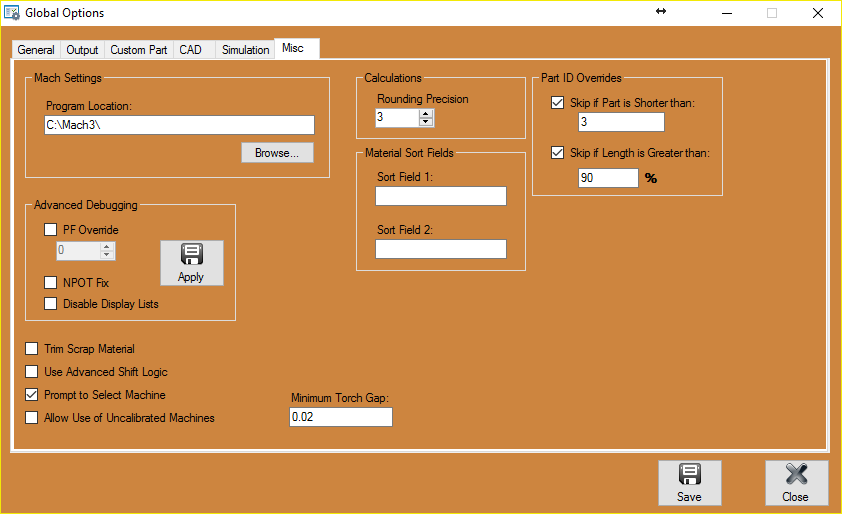Difference between revisions of "Dragon Options"
(→Corner Fix) |
|||
| Line 187: | Line 187: | ||
'''These settings will not be accessible to users by default.''' | '''These settings will not be accessible to users by default.''' | ||
| + | |||
| + | |||
| + | |||
| + | |||
| + | |||
| + | |||
| + | |||
| + | |||
| + | |||
| + | |||
| + | |||
| + | |||
| + | |||
| + | |||
| + | |||
| + | |||
| + | |||
| + | |||
| + | |||
| + | |||
| + | |||
| + | |||
| + | |||
| + | |||
| + | |||
| + | |||
| + | |||
| + | |||
| + | |||
| + | |||
| + | |||
==Output== | ==Output== | ||
Revision as of 08:42, 28 April 2016
Contents
Global Options
General
Default Items
- Default Die: Click on the drop down menu labeled "Default Die:"
 and select a die that you would like to be automatically set when opening a new part.
and select a die that you would like to be automatically set when opening a new part.
- Default Tube/Pipe: Click on the drop down menu labeled "Default Tube/Pipe:"
 and select a material that you would like to be automatically set when opening a new part.
and select a material that you would like to be automatically set when opening a new part.
File Storage
- Data Libraries: Click on the text field labeled "Data Libraries:"
 or click the "Browse"
or click the "Browse"  button to designate a file storage location for your data libraries. This includes dies and material information.
button to designate a file storage location for your data libraries. This includes dies and material information.
- Parts: Click on the text field labeled "Parts:"
 or click the "Browse"
or click the "Browse"  button to designate a file storage location for your saved parts.
button to designate a file storage location for your saved parts.
Tolerances
- Rotation Angle: Click on the drop down menu labeled "Rotation Angle:"
 and select the tolerance for how many decimal places the part's rotation angle will read by default.
and select the tolerance for how many decimal places the part's rotation angle will read by default.
- Bend Angle: Click on the drop down menu labeled "Bend Angle:"
 and select the tolerance for how many decimal places the part's bend angle will read by default.
and select the tolerance for how many decimal places the part's bend angle will read by default.
- Lengths: Click on the drop down menu labeled "Lengths:"
 and select the tolerance for how many decimal places or fraction increments the part's length will read by default.
and select the tolerance for how many decimal places or fraction increments the part's length will read by default.
Unit of Measure
- Millimeters: Select the "Millimeters"
 option and the part dimensions and information will appear in millimeters.
option and the part dimensions and information will appear in millimeters.
Auto-Save Frequency
- Click on the "Auto-Save Frequency"
 drop down menu and select the amount of time it will take for the software to save your progress.
drop down menu and select the amount of time it will take for the software to save your progress.
Input / Interface
- Keyboard: Select the "Keyboard"
 option and the method in which you input your information will be constricted to your keyboard.
option and the method in which you input your information will be constricted to your keyboard.
- Touch Screen: Select the "Touch Screen"
 option and the method in which you input your information will be constricted to your touch screen.
option and the method in which you input your information will be constricted to your touch screen.
Undo/Redo
- Number of Steps: Click the up and down arrows or key in a number into the "Number of Steps:"
 section to designate a number of undo or redo steps you can take when creating a design.
section to designate a number of undo or redo steps you can take when creating a design.
Misc Options
- Invert Mouse Wheel Zoom: Check the "Invert Mouse Wheel Zoom"
 checkbox and the mouse's zoom function will become inverted (scroll up to zoom out/ scroll down to zoom in).
checkbox and the mouse's zoom function will become inverted (scroll up to zoom out/ scroll down to zoom in).
- Disable Automatic Updates: Check the "Disable Automatic Updates"
 checkbox and the software will no longer attempt to update automatically.
checkbox and the software will no longer attempt to update automatically.
- Display Orientation Axis: Check the "Display Orientation Axis"
 checkbox and the orientation axis will be shown on the display screen.
checkbox and the orientation axis will be shown on the display screen.
Main Display
- Normal: Click on the "Normal"
 option and the background in the display screen will be normal by default.
option and the background in the display screen will be normal by default.
- Custom Color:' Click on the "Custom Color"
 option and choose a default color to assign to the background in the display screen.
option and choose a default color to assign to the background in the display screen.
- Image: Click the "Image"
 option and browse for a default picture to assign to the background in the display screen.
option and browse for a default picture to assign to the background in the display screen.
Machine
Basic Settings
Default Process Order
- Default Process Order Box: This box will contain the 4 different processes that will take place in the fabrication process
 (Marking, Engraving, Polyline Cutting and Cutting). To order these in the way you want them, select one from the list and use the Up
(Marking, Engraving, Polyline Cutting and Cutting). To order these in the way you want them, select one from the list and use the Up  and Down
and Down  arrows to decide the procession.
arrows to decide the procession.
- Order by Part: Click the "Order by Part"
 option to assign the process order to each individual part.
option to assign the process order to each individual part.
- Order by Shift: Click the "Order by Shift"
 option to assign the process order to each individual shift.
option to assign the process order to each individual shift.
Misc Options
- Long Travel Minimum: Enter a value in the "Long Travel Minimum"
 text field to indicate the least amount of distance that the machine will travel to still be considered a 'long travel'. A long travel will most likely be when the machine travels from one set of contours to another, or one end of tubing to another.
text field to indicate the least amount of distance that the machine will travel to still be considered a 'long travel'. A long travel will most likely be when the machine travels from one set of contours to another, or one end of tubing to another.
- Loading Offset: When using a material with a diameter larger than 3 inches, enter a value in the "Loading Offset"
 text field to indicate the offset distance to the end of the tubing.
text field to indicate the offset distance to the end of the tubing.
- Display Jaws: Check the "Display Jaws"
 checkbox to show the jaws of the chuck in any nesting project.
checkbox to show the jaws of the chuck in any nesting project.
- Display Dead Zone: Check the "Display Dead Zone"
 checkbox to show the dead zone (or space of tubing that will not reach to the tool changer) in any nesting project.
checkbox to show the dead zone (or space of tubing that will not reach to the tool changer) in any nesting project.
- Reduce Part Shifts: Check the "Reduce Part Shifts"
 checkbox and the software will automatically reduce the amount of shifts needed in a nesting project.
checkbox and the software will automatically reduce the amount of shifts needed in a nesting project.
- Warn about Possible Crashes: Keep this check box checked to ensure that you are warned before possible crashes in the software.
- Jaw Color: Click the "Jaw Color"
 button in order to change the default color shown to indicate the chuck's jaws in any nesting project. This color is blue by default.
button in order to change the default color shown to indicate the chuck's jaws in any nesting project. This color is blue by default.
- Dead Zone Color: Click the "Dead Zone Color"
 button in order to change the default color shown to indicate the dead zone (section of tubing that cannot be cut with the Dragon machine because the tubing will not span the distance from the chuck to the tool changer head) in any nesting project. This color is grey be default.
button in order to change the default color shown to indicate the dead zone (section of tubing that cannot be cut with the Dragon machine because the tubing will not span the distance from the chuck to the tool changer head) in any nesting project. This color is grey be default.
Bend Marks (Default)
- None: Select the "None"
 option if you would not like the bend marks assigned to an action by default.
option if you would not like the bend marks assigned to an action by default.
- Mark: Select the "Mark"
 option if you would like the bend marks to be marked with a marker by default.
option if you would like the bend marks to be marked with a marker by default.
End Cuts (Default)
- Cut:' Select the "Cut"
 option if you would like the end cuts to be cut with the machine's plasma cutter by default.
option if you would like the end cuts to be cut with the machine's plasma cutter by default.
- Mark: Select the "Mark"
 option if you would like the end cuts to be marked with a marker by default.
option if you would like the end cuts to be marked with a marker by default.
Part ID Marking
- Enable Part ID Marking: Check the "Enable Part ID Marking"
 checkbox and your part will be either marked or engraved with the part ID information by default.
checkbox and your part will be either marked or engraved with the part ID information by default.
- Part ID Font: Click on the "Part ID Font"
 drop down menu to choose the font that the part ID will be marked or engraved in by default.
drop down menu to choose the font that the part ID will be marked or engraved in by default.
- Part ID Size: Enter a value in the "Part ID Size"
 text field to designate a size of the part ID lettering. This will be in inches or millimeters depending on what your units of measurement are set to.
text field to designate a size of the part ID lettering. This will be in inches or millimeters depending on what your units of measurement are set to.
- Part ID Location: Enter a value in the "Part ID Location"
 text field to designate a location down the length of the tubing where the part ID will be located by default.
text field to designate a location down the length of the tubing where the part ID will be located by default.
Saddles (Default)
Holesaw Info (Default)
- None: Select the "None"
 option if you would not like the holesaw information assigned to an action by default.
option if you would not like the holesaw information assigned to an action by default.
- Mark: Select the "Mark"
 option if you would like the holesaw information to be marked with a marker by default.
option if you would like the holesaw information to be marked with a marker by default.
- Engrave: Select the "Engrave"
 option if you would like the holesaw information to be engraved by default.
option if you would like the holesaw information to be engraved by default.
Cutter Settings
Cutting Tool
- Lift Amount (Short): Enter the height of the lift amount for a short distance travel of the plasma head in the "Lift Amount (Short)"
 text field.
text field.
- Lift Amount (Long): Enter the height of the lift amount for a long distance travel of the plasma head in the "Lift Amount (Long)"
 text field.
text field.
Corner Fix
- Add Dwell: Click on the "Add Dwell"
 option to ensure that a corner of two contours is cut appropriately by adding a small delay in the cut. The plasma torch will pause momentarily to avoid a cornered radius on what is meant to be a smooth transition between straight cuts.
option to ensure that a corner of two contours is cut appropriately by adding a small delay in the cut. The plasma torch will pause momentarily to avoid a cornered radius on what is meant to be a smooth transition between straight cuts.
- Add Line: Click on the "Add Line"
 option to ensure that a corner of two contours is cut appropriately by adding a small line to the cut. This will avoid a delay and a cornered radius on what is meant to be a smooth transition between straight cuts. This is the preferred method.
option to ensure that a corner of two contours is cut appropriately by adding a small line to the cut. This will avoid a delay and a cornered radius on what is meant to be a smooth transition between straight cuts. This is the preferred method.
- None: Click on the "None"
 option and the software will not add a fix for cornered radii when cutting adjacent contours.
option and the software will not add a fix for cornered radii when cutting adjacent contours.
- Min Angle: Enter the minimum angle possible in order to require a corner fix in the "Min Angle:"
 text field.
text field.
- Line Length: When the Add Line option is selected, enter the line length allotted for the contour in the "Line Length"
 text field.
text field.
Pause for Drops
- Enable Pausing: Check the "Enable Pausing"
 checkbox to cause the plasma torch to pause when finishing a through-cut or cope. This will ensure a clean cut-off.
checkbox to cause the plasma torch to pause when finishing a through-cut or cope. This will ensure a clean cut-off.
- Minimum Length: Enter a value in the "Minimum Length:"
 text field which will determine the minimum length needed before a pause can occur on an end cut.
text field which will determine the minimum length needed before a pause can occur on an end cut.
Travel Direction
- Right: Click on the "Right"
 option and the cutting direction will always start from the left and move to the right.
option and the cutting direction will always start from the left and move to the right.
- Left: Click on the "Left"
 option and the cutting direction will always start from the right and move to the left.
option and the cutting direction will always start from the right and move to the left.
Engraver Settings
Engraver Tool:
- Lift Amount (Short): Enter the height of the lift amount for a short distance travel of the engraver head in the "Lift Amount (Short)"
 text field.
text field.
- Lift Amount (Long): Enter the height of the lift amount for a long distance travel of the plasma head in the "Lift Amount (Long)"
 text field.
text field.
Corner Fix
- Add Dwell: Click on the "Add Dwell"
 option to ensure that a corner of two contours is engraved appropriately by adding a small delay in the etching. The engraver will pause momentarily to avoid a cornered radius on what is meant to be a smooth transition between straight etches.
option to ensure that a corner of two contours is engraved appropriately by adding a small delay in the etching. The engraver will pause momentarily to avoid a cornered radius on what is meant to be a smooth transition between straight etches.
- Add Line: Click on the "Add Line"
 option to ensure that a corner of two contours is engraved appropriately by adding a small line to the contours. This will avoid a delay and a cornered radius on what is meant to be a smooth transition between straight etches. This is the preferred method.
option to ensure that a corner of two contours is engraved appropriately by adding a small line to the contours. This will avoid a delay and a cornered radius on what is meant to be a smooth transition between straight etches. This is the preferred method.
- None: Click on the "None"
 option and the software will not add a fix for cornered radii when engraving adjacent contours.
option and the software will not add a fix for cornered radii when engraving adjacent contours.
- Min Angle: Enter the minimum angle possible in order to require a corner fix in the "Min Angle:"
 text field.
text field.
- Line Length: When the Add Line option is selected, enter the line length allotted for the contour in the "Line Length"
 text field.
text field.
Marker Settings
Marking Tool:
- Lift Amount (Short): Enter the height of the lift amount for a short distance travel of the engraver head in the "Lift Amount (Short)"
 text field.
text field.
- Lift Amount (Long): Enter the height of the lift amount for a long distance travel of the plasma head in the "Lift Amount (Long)"
 text field.
text field.
Corner Fix
- Add Dwell: Click on the "Add Dwell"
 option to ensure that a corner of two contours is marked appropriately by adding a small delay in the marking. The marker will pause momentarily to avoid a cornered radius on what is meant to be a smooth transition between straight marks.
option to ensure that a corner of two contours is marked appropriately by adding a small delay in the marking. The marker will pause momentarily to avoid a cornered radius on what is meant to be a smooth transition between straight marks.
- Add Line: Click on the "Add Line"
 option to ensure that a corner of two contours is marked appropriately by adding a small line to the contours. This will avoid a delay and a cornered radius on what is meant to be a smooth transition between straight marks. This is the preferred method.
option to ensure that a corner of two contours is marked appropriately by adding a small line to the contours. This will avoid a delay and a cornered radius on what is meant to be a smooth transition between straight marks. This is the preferred method.
- None: Click on the "None"
 option and the software will not add a fix for cornered radii when marking adjacent contours.
option and the software will not add a fix for cornered radii when marking adjacent contours.
- Min Angle: Enter the minimum angle possible in order to require a corner fix in the "Min Angle:"
 text field.
text field.
- Time (milliseconds): When the Add Dwell option is selected, enter the time allotted for a pause in marking in the "Time (milliseconds)"
 text field.
text field.
Factory Settings
These settings will not be accessible to users by default.
Output
Rotation
The rotation settings control how rotation values are displayed in the results table. Rotation can be measured in incremental or absolute terms. Each rotation angle range can also be chosen.
- Incremental: Select the "Incremental:"
 option and rotation angles will start from the end of the previous bend's rotation.
option and rotation angles will start from the end of the previous bend's rotation.
- Absolute: Select the "Absolute:"
 option and rotation angles will always start from the very beginning of the angle scale.
option and rotation angles will always start from the very beginning of the angle scale.
- Angle Scale: The rotation scale will determine what the rotation angles will range between. The rotation scale will show where the angle measurements begin and where they end. Choose a rotation scale by clicking on one of the scale options. The rotation scales available are 0 - 360, 360 - 0, (-180) - 180, and 180 - (-180). The 0 - 90 - 0 - 90 - 0 and 0 - 90 - 0 - 90 - 0 Reversed options will be added when the Absolute option is chosen.
Length/Location
The length/location setting will determine how the bend location will be calculated in the results table.
- Distance from Start: Select the "Distance from Start"
 option and bend locations will be measured from the starting edge of the tube.
option and bend locations will be measured from the starting edge of the tube.
- Distance from End: Select the "Distance from End"
 option and bend locations will be measured from the ending edge of the tube.
option and bend locations will be measured from the ending edge of the tube.
- Length of Straight Tube: Select the "Length of Straight Tube"
 option and bend location values will be the amount of straight tube between each bend.
option and bend location values will be the amount of straight tube between each bend.
- Table Location: Select the "Table Location"
 option and bend locations will be based on index table values. If this option is used, the "Offset Distance"
option and bend locations will be based on index table values. If this option is used, the "Offset Distance"  between the table and the bend will need to be supplied as well as scale "Table Length"
between the table and the bend will need to be supplied as well as scale "Table Length"  . Check the "Indexing Begins at Die"
. Check the "Indexing Begins at Die"  option if the scale begins at the die.
option if the scale begins at the die.
- Dimension Location:
 This option determines where the bend location marks will be placed in reference to the bend. Bend locations can be placed at the start, center, or end of each bend.
This option determines where the bend location marks will be placed in reference to the bend. Bend locations can be placed at the start, center, or end of each bend.
Misc Display Options
- Display parentheses () for negative values: Check the "Display parentheses () for negative values"
 checkbox and all negative values in the output results table will be surrounded by parentheses.
checkbox and all negative values in the output results table will be surrounded by parentheses.
- Display Degree Symbol: Check the "Display Degree Symbol"
 checkbox and the degree symbol will be shown in the output results table.
checkbox and the degree symbol will be shown in the output results table.
- Display Feet/Meters: Check the "Display Feet/Meters"
 checkbox and the lengths of each tube including overall lengths will be shown as feet or meters in the output results table.
checkbox and the lengths of each tube including overall lengths will be shown as feet or meters in the output results table.
- Display Minutes/Seconds: Check the "Display Minutes/Seconds"
 checkbox and the minutes and/or seconds for fabrication time will be shown in the output results table.
checkbox and the minutes and/or seconds for fabrication time will be shown in the output results table.
- Display Spring Angles: Check the 'Display Spring Angles"
 checkbox and the part's spring angles will be shown in the output results table.
checkbox and the part's spring angles will be shown in the output results table.
- Display Length of Bend: Check the "Display Length of Bend"
 checkbox and the lengths of each bend on a part will be shown in the output results table.
checkbox and the lengths of each bend on a part will be shown in the output results table.
Custom Part
Defaults
- Cut-Off Color: Select the color that will be assigned to the section of cut-off added to the part by clicking the color box next to the "Cut-Off Color:"
 heading.
heading.
- Tri-Star Scale: Enter a value in the "Tri-Star Scale:"
 text field to assign a size to the scale of the Tri-Star. 1=100% (Normal Size), 2=200% (Twice the Normal Size).
text field to assign a size to the scale of the Tri-Star. 1=100% (Normal Size), 2=200% (Twice the Normal Size).
- Dimension Size: Enter a value in the "Dimension Size:"
 text field to assign a size to the dimensions shown on your parts. 1=100% (Normal Size), 2=200% (Twice the Normal Size).
text field to assign a size to the dimensions shown on your parts. 1=100% (Normal Size), 2=200% (Twice the Normal Size).
Misc Custom Part Options
- Reverse Rotation: Check the "Reverse Rotation"
 checkbox to ensure that the rotation settings are shown in reverse.
checkbox to ensure that the rotation settings are shown in reverse.
Features to Display
These settings will determine the kind of features that will be displayed on the part model in any of the single part design interfaces. Click the check boxes next to the features you want to have shown.
- Dimensions: Length measurement values will be displayed on the part lengths.
- Cut-Off: If any cut-off is added to the part, it will be represented on the part display.
- Apex Guides: For each bend, guidelines will extend from the part model to the verification points.
- Tri-Star: The axis will be shown on the graphical display.
- Verification Points: Points will be displayed at the apex of each bend.
- Bend Highlight: The current bend will be highlighted in red on the 3D part model.
Cut-Off
- The default cut-off start and end values can be defined here. Each new part will automatically have these cut-offs initially applied.
CAD
Dimensions
- Text Size: Enter the default text size for when you create dimensions within a project. This will be set to 1 be default.
- Ext. Offset: Enter the distance that straight extensions will protrude from placed dimensions. This will be set to 0 by default.
- Ext. Standoff: Enter the distance from the dimension points that straight sections will start from. This will be set to 0 by default.
- Arrow Width: Enter the width of your arrows for placed dimensions. This will be set to 0.5 by default.
- Arrow Length: Enter the length of your arrows for placed dimensions. This will be set to 1 by default.
- Arrow Type: Choose the arrow type for placed dimensions. Options are None, Single, Double, Closed, and Solid. This will be set to Double by default.
- Angle Tolerance: Choose how specific your angle dimensions will read out when placed. This will be set to 'n' by default.
- Tolerance: Choose the tolerance of either fractions or decimals for your horizontal, vertical and linear placed dimensions. This will be set to 'Fraction n/16' by default.
Holes - Default Values
- Round Select the Round option and you will be able to adjust the default width of round holes in the corresponding Width: value field. This will be set to 1 by default.
- Square Select the Square option and you will be able to adjust the default width, angle and corner radius of square holes in the corresponding Width:, Angle: and Corner Radius:' value fields. These will be set to 1, 0 and 0 by default.
- Rectangle Select the Rectangle option and you will be able to adjust the default width, angle, height and corner radius of rectangular holes in the corresponding Width:, Angle:, Height: and Corner Radius: value fields. These will be set to 1, 0, 2 and 0 by default.
- Oval Select the Oval option and you will be able to adjust the default width, angle and height of oval holes in the corresponding Width:, Angle: and Height: value fields. These will be set to 1, 0 and 2 by default.
- Ellipse Select the Ellipse option and you will be able to adjust the default width, angle and height of ellipse holes in the corresponding Width:, Angle: and Height: value fields. These will be set to 1, 0 and 2 by default.
Drawing Weight
This section will determine the thickness of lines for each of the categories included.
- Material: Enter the material drawing weight here. This will be set to 1 by default.
- Points: Enter the points drawing weight here. This will be set to 1 by default.
- Lines: Enter the lines drawing weight here. This will be set to 1 by default.
- Holes: Enter the holes drawing weight here. This will be set to 1 by default.
- Text: Enter the text drawing weight here. This will be set to 1 by default.
- Dimensions: Enter the dimension drawing weight here. This will be set to 1 by default.
- Marking: Enter the marking drawing weight here. This will be set to 2 by default.
- Etching: Enter the etching drawing weight here. This will be set to 2 by default.
- Cutting: Enter the cutting drawing weight here. This will be set to 3 by default.
Abbreviations
This section is for setting up your abbreviations for holes made in Dragon's designer. These will be shown when you dimension the holes on the project.
- Round: Enter the abbreviation for round holes in the text field here. This will be set to Rd. by default.
- Square: Enter the abbreviation for square holes in the text field here. This will be set to Sq. by default.
- Rectangle: Enter the abbreviation for rectangle holes in the text field here. This will be set to Rect. by default.
- Oval: Enter the abbreviation for oval holes in the text field here. This will be set to Ov. by default.
- Ellipse: Enter the abbreviation for ellipse holes in the text field here. This will be set to Elps. by default.
Colors
This section is for setting colors to the different actions and lines that will appear in your design.
- Marking Set the color that will indicate marking here. This will be set to green by default.
- Etching Set the color that will indicate etching here. This will be set to purple by default.
- Cutting Set the color that will indicate cutting here. This will be set to dark red by default.
- Tube Edge Set the color that will indicate the tube edge here. This will be set to dark pink by default.
- Lead-in Set the color that will indicate the plasma lead-in here. This will be set to red by default.
- Lead-Out Set the color that will indicate the plasma lead-out here. This will be set to pink by default.
- Points Set the color that will indicate points here. This will be set to black by default.
- Lines Set the color that will indicate lines here. This will be set to black by default.
- Text Set the color that will indicate text here. This will be set to gray by default.
- Holes Set the color that will indicate holes here. This will be set to gray by default.
- Dimension Lines Set the color that will indicate dimension lines here. This will be set to black by default.
- Dimension Ext Set the color that will indicate dimension extension lines here. This will be set to black by default.
- Dimension Text Set the color that will indicate dimension text here. This will be set to black by default.
Text
This section is for setting up your text defaults.
- Size: Enter the size of your text here. This will be set to 1 be default.
- Spacing: Enter the gap of your text spacing here. This will be set to 1 be default.
- Text Quality: Choose the visual quality of your text here. This will be set to Normal be default.
- Font Family: Choose the font used with your text here. This will be set to Arial be default.
Simulation
This section is where you will set up your default settings for bending simulation.
- Travel Speed: Set the speed of travel during a bend simulation here. This will be set to 2 by default.
- Bending Speed: Set the speed of bending during a bend simulation here. This will be set to 5 by default.
- Rotation Speed: Set the speed of rotation during a bend simulation here. This will be set to 5 by default.
- Animation Speed: Set the speed of animation during a bend simulation here. This will be set to 5 by default.
- Bender: Set your style of bender during a bend simulation here. This will be set to Rotary Draw - Clockwise by default.
- Quality: Set your visual quality during a bend simulation here. This will be set to Best by default.
- POB Bracket Color: Set your POB bracket color during a bend simulation here. This will be set to gray by default.
Misc
Mach Settings
- Program Location: Set the location of your Mach program by either entering the path location in the text field or browsing for it by clicking the Browse button.
Advanced Debugging
These advanced debugging options should only be altered under the direction of a Bend-Tech support technician.
Calculations
- Rounding Precision This value represents the number of decimal points that the software will round off by in cases when numbers are rounded.
Miscellaneous Options
- Display Action Directions When this checkbox is checked, the action directions will be displayed within a nesting project. These are small arrows on the contours of the part's geometry that indicate the path of actions that the machine will take in order to complete its actions.
- Display Transition Paths When this checkbox is checked, the transition paths will be displayed within a nesting project. These are dashed lines that indicate the path that the machine head will take in order to complete its shifts.
- Trim Part Ends When this checkbox is checked, the ends of the part will be trimmed back to the cut location in order to save as much material as possible.
